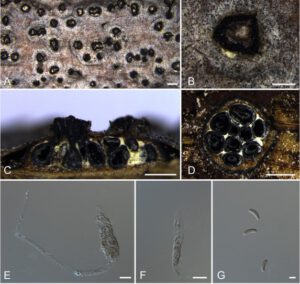Allocryptovalsa castaneicola N. Jiang & X.L. Fan, in Zhu, Pan, Wijayawardene, Jiang, Ma, Dai, Tian & Fan, Frontiers in Microbiology 12(no. 646262): 7 (2021)
Index Fungorum Number: IF 837787, MycoBank Number: MB 837787, Facesoffungi Number: FoF 14961
Etymology – Named after the host genus from which it was collected, Castanea.
Diagnosis – Allocryptovalsa castaneicola differs from other Allocryptovalsa species by its polysporous asci and larger size of ascospores (22–25 × 5–6 mm).
Descriptions – Necrotrophic on branches of Castanea mollissima. Sexual morph: Stromata scattered to gregarious, immersed in the bark, erumpent through the surface of bark, with 8–10 perithecia arranged irregularly (1.5–)1.7–2.0 mm (av. = 1.8 ± 0.2 mm, n = 10) in diam. Ectostromatic disc brown, circular to oblong, with more than 10 ostioles arranged circularly per disc, 0.7–0.9(–1.0) mm (av. = 0.8 ± 0.1 mm, n = 10) in diam. Ostioles numerous, gregarious, umbilicate, 4-sulcate dark brown to black, at the same level as the disc, 104–120(–140) mm (av. = 114.9 ± 11.3 mm, n = 10) in diam. Perithecia outer surface coated with yellow, powdery entostromablack, flask-shaped, perithecial necks erumpent in groups (200–)250–320(–380) mm (av. = 282.7 ± 49.8 mm, n = 10) in diam. Asci clavate to elongate obovoid, polysporous, thin-walled, long pedicellate, apically flat, 194–202 × 15–21 mm (av. = 198.4 ± 3.3 × 18.9 ± 0.5 mm, n = 10). Ascospores elongate-allantoid, thin-walled, pale yellowish to pale brown at maturity, slightly curved, aseptate, smooth, 22–25 × 5–6 mm (av. = 23.8 ± 1.1 × 5.4 ± 0.3 mm, n = 30). Asexual morph: not observed.
Culture characteristics – Colonies are initially white, uniform, becoming dark after 2 weeks.
Typification – CHINA. Hebei Province, Chengde City, Kuancheng Manchu Nationality Autonomous County, 118◦2705400 E 40◦3803700 N, 450 m msl., from branches of Castanea mollissima, 14 Oct. 2017, C.M. Tian & N. Jiang, holotype BJFU CF2020519, ex-type culture CFCC 52432. Hebei Province, Chengde City, Kuancheng Manchu Nationality Autonomous County, 118◦2705400 E 40◦3803700 N, 450 m msl., from branches of Castanea mollissima, 14 Oct. 2017, C.M. Tian & N. Jiang, isotype BJM 240515.
Known host and distribution – Known only on Castanea mollissima in Hebei Province, China.
Notes – The new species displays some features of morphology typical of the recent genus Allocryptovalsa (well-developed ascostromata producing polysporous asci and allantoid ascospores) (Senwanna et al., 2017), although it appears closer placed in Eutypella sensu lato (Figure 1; Clade 12). Morphologically, Allocryptovalsa castaneicola differs from the closest species Eutypella australiensis by larger size of asci (194–202 × 15–21 vs. 40–50 × 7–8.5 mm) and ascospores (22–25 × 5–6 vs. 8–10 × 3 mm) (Trouillas et al., 2010a). Allocryptovalsa castaneicola was also distinguished from other Eutypella species resembles by having polysporous asci rather than the 8-spored asci (Trouillas et al., 2010b). Thus, we introduce it here as a new species in genus Allocryptovalsa. Moreover, Allocryptovalsa castaneicola can differ from Cryptovalsa species by having a yellow rather than white powdery entostroma appeared on the ascomatal outer surface (Dayarathne et al., 2020b). Also, phylogenetic analyses show affinities of this fungus with strains from Eutypella spp. Therefore, the assignment of the strains to the genus Eutypella sensu lato may require future reconsideration.

Figure 1. Sexual morph of Allocryptovalsa castaneicola (BJFU CF2020519, holotype). (A) Ascomata on the host. (B) Ascoma on the host. (C) Longitudinal section through ascoma. (D) Transverse section of ascoma. (E,F) Ascus and ascospores. (G) Ascospores. Scale bars: (A) = 1 mm; (B–D) = 500 mm; (E–G) = 10 mm.
